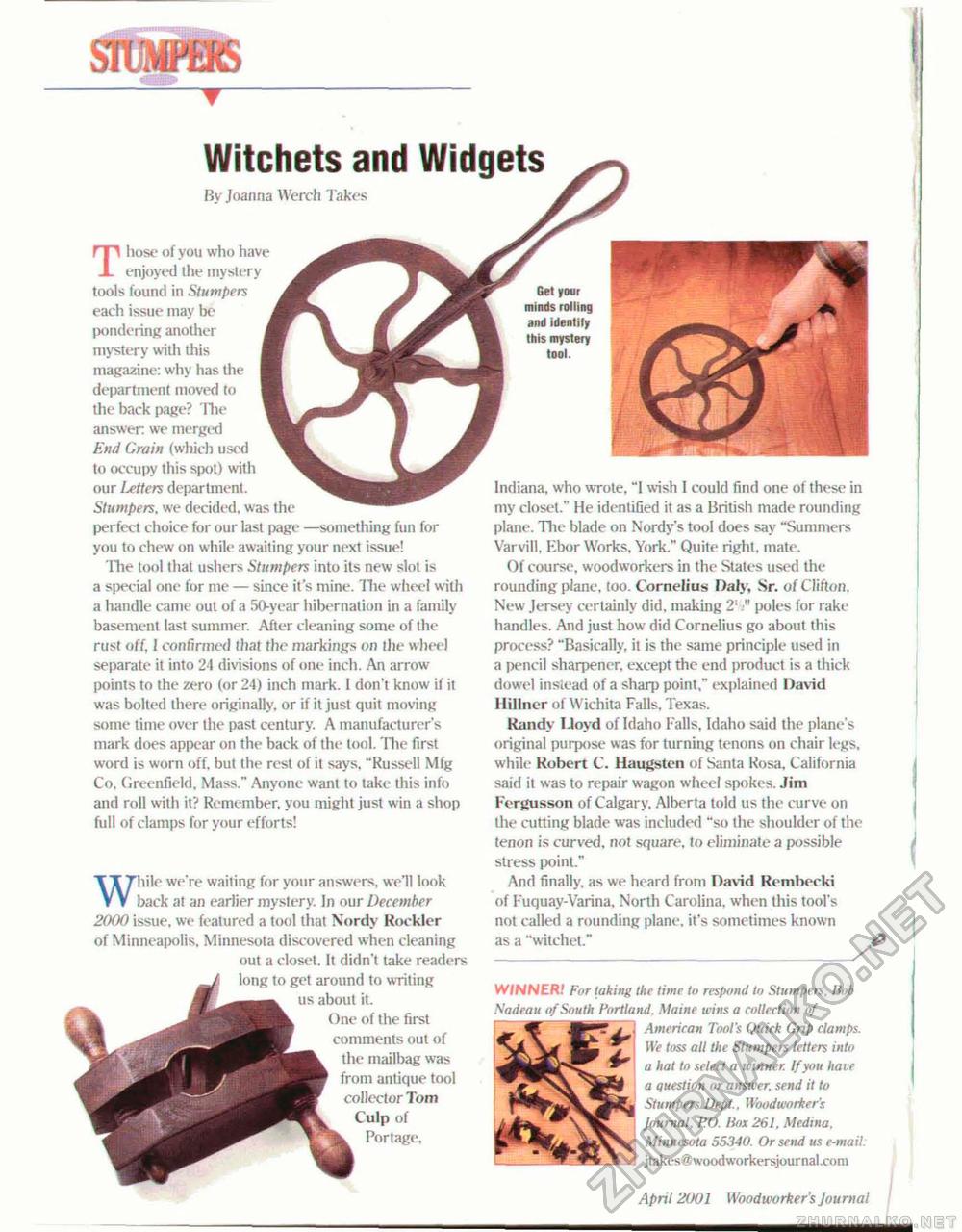Woodworker's Journal 2001-25-2, страница 90
Witchets and Widgets By Joanna Werch l akes Those of you who have enjoyed the mystery tools found in Stumpers each issue may be pondering another mystery with this magazine: why has the department moved to the back page? The answer we merged End Grain {which used to occupy this spot) with our letters department. Stumpers, we decided, was the perfect choice for our last page —something fun for you to chew on while awaiting your next issue! The tool that ushers Stumpers into its new slot is a special one for me — since it's mine. Hie wheel with a handle came out of a 50-year hibernation in a family basement last summer. After cleaning some of the rust off, 1 confirmed that the markings on the wheel separate it into 24 divisions of one inch. An arrow points to the zero (or 24) inch mark. I don't know if it was bolted there originally, or if it just quit moving some time over the past century. A manufacturer's mark does appear on the back of the tool. "Hie first word is worn off, but the rest of it says. "Russell Mfg Co, Greenfield, Mass." Anyone want to take this info and roll with it? Remember, you might just win a shop full of clamps for your efforts! While we're waiting for your answers, we'll look back at an earlier mystery. In our December 2000 issue, we featured a tool that Nordy Rockier of Minneapolis. Minnesota discovered when cleaning out a closet. It didn't take readers long to get around to writing us about it. One of the first comments oul of the niailbag was from antique tool collector Tom Culp of Portage. Indiana, who wrote. "I wish 1 could find one of these in my closet." He identified it as a British made rounding plane. The blade on Nordy's tool does say "Summers Varvill. Ebor Works, York." Quite right, mate. Of course, woodworkers in the Slates used tile rounding plane, too. Cornelius Daly, Sr. of Clifton, New Jersey certainly did, making 2V poles for rake handles. And just how did Cornelius go about this process? "Basically, it is the same principle used in a pencil sharpener, except the end product is a thick-dowel instead of a sharp point," explained David I iillner of Wichita Falls, Texas. Randy I Joyd of Idaho Fails, Idaho said the plane's original purpose was for turning tenons on chair legs, while Robert C. llaugsten of Santa Rosa, California said it was to repair wagon wheel spokes. Jim Fergusson of Calgary, Alberta told us the curve on the cutting blade was included "so the shoulder of the tenon is curved, not square, to eliminate a possible stress point." And finally, as we beard from David Rembecki of Fuquay-Varina, North Carolina, when this tool's not called a rounding plane, it's sometimes known as a "witchet." Get your minds rolling and identify this mystery tool. W7NNER.1 For taking the time to respond to Stumpers. Hob Nadeau of South Portland, Maine wins a collection of American Tool's Quick Grip clamps. We toss all the Stumpers letters into a hat to select a winner If you have a question or answer, send it to Stumpers Dept., Woodworker's Journal, PO. Box 261. Medina. Minnesota 55340. Or send us e-mai! jtakes woodworkersjour nal .com 90 April 2001 Woodworker 's Journal |







